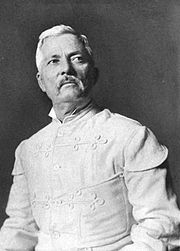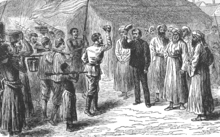- Henry Morton Stanley
-
Sir Henry Morton Stanley 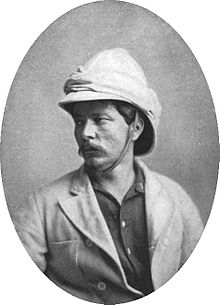
Journalist and explorerBorn John Rowlands
28 January 1841
Denbigh, WalesDied 10 May 1904 (aged 63)
London, EnglandSignature 
Sir Henry Morton Stanley, GCB, born John Rowlands (28 January 1841 – 10 May 1904), was a Welsh journalist and explorer famous for his exploration of Africa and his search for David Livingstone. Upon finding Livingstone, Stanley allegedly uttered the now-famous greeting, "Dr. Livingstone, I presume?" His legacy of death and destruction in the Congo region is considered an inspiration for Joseph Conrad's Heart of Darkness.[1]
Contents
Early life
When Stanley was born in Denbigh, Wales, his mother, Elizabeth Parry, was just 19 years old. He never knew his father who died within a few weeks of his birth;[2] there is some doubt as to his true parentage.[3] His parents were unmarried, so his birth certificate refers to him as a bastard and the stigma of illegitimacy weighed heavily upon him all his life.
Originally taking his father's name of Rowlands, Stanley was brought up by his grandfather until the age of five. When his guardian died, Stanley stayed at first with cousins and nieces for a short time, but was eventually sent to St. Asaph Union Workhouse for the poor, where overcrowding and lack of supervision resulted in frequent abuse by the older boys. When he was ten, his mother and two siblings stayed for a short while in this workhouse, without Stanley realising who they were. He stayed until the age of 15. After completing an elementary education, he was employed as a pupil teacher in a National School.
New country, new name
In 1859, at the age of 18, he made his passage to the United States in search of a new life. Upon arriving in New Orleans, he absconded from his boat. According to his own declarations, he became friendly with a wealthy trader named Henry Hope Stanley, by accident: he saw Stanley sitting on a chair outside his store and asked him if he had any job opening for a person such as himself. However, he did so in the British style, "Do you want a boy, sir?" As it happened, the childless man had indeed been wishing he had a boy of his own, and the inquiry led not only to a job, but to a close relationship.[4] The youth ended up taking Stanley's name. Later, he would write that his adoptive parent had died only two years after their meeting, but in fact the elder Stanley did not die until much later in 1878.[5] In any case, young Stanley assumed a local accent and began to deny being a foreigner.
Stanley participated reluctantly[6] in the American Civil War, first joining the Confederate Army and fighting in the Battle of Shiloh in 1862.[7] After being taken prisoner he promptly deserted and joined the Union Army, but was discharged on 22 June 1862 due to severe illness[8] Recovering, he served on several merchant ships before joining the Navy in July 1864. On board the Minnesota he became a record keeper, which led to freelance journalism. Stanley and a junior colleague jumped ship on 10 February 1865 in New Hampshire in search of greater adventures.[9]
Following the Civil War, Stanley began a career as a journalist. As part of this new career, Stanley organised an expedition to the Ottoman Empire that ended catastrophically when Stanley was imprisoned. He eventually talked his way out of jail and even received restitution for damaged expedition equipment.[citation needed] This early expedition may have formed the foundation for his eventual exploration of the Congo region of Africa.[citation needed]
In 1867, Stanley was recruited by Colonel Samuel Forster Tappan (a one-time journalist) of the Indian Peace Commission, to serve as a correspondent to cover the work of the Commission for several newspapers. Stanley was soon retained exclusively by James Gordon Bennett (1795–1872), founder of the New York Herald, who was impressed by Stanley's exploits and by his direct style of writing. This early period of his professional life is described in Volume I of his book My Early Travels and Adventures in America and Asia (1895). He became one of the Herald's overseas correspondents and, in 1869, was instructed by Bennett's son to find the Scottish missionary and explorer David Livingstone, who was known to be in Africa but had not been heard from for some time. According to Stanley's account, he asked James Gordon Bennett, Jr. (1841–1918), who had succeeded to the paper's management after his father's retirement in 1867, how much he could spend. The reply was "Draw £1,000 now, and when you have gone through that, draw another £1,000, and when that is spent, draw another £1,000, and when you have finished that, draw another £1,000, and so on — BUT FIND LIVINGSTONE!" In actuality, Stanley had lobbied his employer for several years to mount this expedition that would presumably give him fame and fortune.
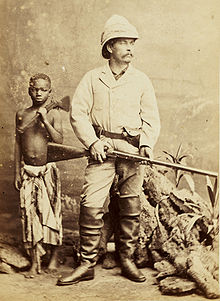 1872 Carte de visite – Stanley and Kalulu.
1872 Carte de visite – Stanley and Kalulu.
Finding Livingstone
Stanley travelled to Zanzibar in March 1871 and outfitted an expedition with the best of everything, requiring no fewer than 200 porters. This 7,000 miles (11,000 km) expedition through the tropical forest became a nightmare. His thoroughbred stallion died within a few days after a bite from a Tsetse fly, many of his carriers deserted and the rest were decimated by tropical diseases. To keep the expedition going, he had to take stern measures, including flogging deserters. Many missionaries of the day practiced tactics no less brutal than his, and Stanley's diaries show that he had in fact exaggerated the brutal treatment of his carriers in his books to pander to the taste of his Victorian public. Some recent authors suggest that Stanley's treatment of indigenous porters helps to refute his reputation as a brutal criminal.[10] However, statements by contemporaries of Stanley like Sir Richard Francis Burton, who claimed "Stanley shoots negroes as if they were monkeys", paint a very different picture.[11] Stanley found Livingstone on 10 November 1871, in Ujiji near Lake Tanganyika in present-day Tanzania, and may have greeted him with the now-famous, "Doctor Livingstone, I presume?" This famous phrase may be a fabrication, as Stanley tore out of his diary the pages relating to the encounter.[12] Even Livingstone's account of the encounter fails to mention these words. However, a summary of Stanley's letters published by The New York Times on 2 July 1872, quotes the phrase.[13] However, Tim Jeal argues in his biography that Stanley invented it afterwards because of his "insecurity about his background".[14]
The Herald's own first account of the meeting, published 2 July 1872, also includes the phrase: "Preserving a calmness of exterior before the Arabs which was hard to simulate as he reached the group, Mr. Stanley said: – `Doctor Livingstone, I presume?' A smile lit up the features of the hale white man as he answered: "Yes, and I feel thankful that I am here to welcome you. ..."[15][16]
Stanley joined Livingstone in exploring the region, establishing for certain that there was no connection between Lake Tanganyika and the River Nile. On his return, he wrote a book about his experiences : How I Found Livingstone; travels, adventures, and discoveries in Central Africa.[17] This brought him into the public eye and gave him some financial success.[citation needed]
Researching the Congo River
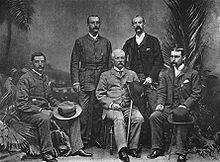 Henry M Stanley with the officers of the Advance Column, Cairo, 1890. From the left : Dr. Thomas Heazle Parke, Robert H. Nelson, Henry M. Stanley, William G. Stairs, and Arthur J. M. Jephson
Henry M Stanley with the officers of the Advance Column, Cairo, 1890. From the left : Dr. Thomas Heazle Parke, Robert H. Nelson, Henry M. Stanley, William G. Stairs, and Arthur J. M. Jephson Main article: Henry Morton Stanley's first trans-Africa exploration
Main article: Henry Morton Stanley's first trans-Africa explorationIn 1874, the New York Herald, in partnership with Britain's Daily Telegraph, financed Stanley on another expedition to the African continent. One of his missions was to solve a last great mystery of African exploration by tracing the course of the Congo River to the sea. The difficulty of this expedition is hard to overstate. Stanley used sectional boats to pass the great cataracts separating the Congo into distinct tracts. After 999 days, on 9 August 1877, Stanley reached a Portuguese outpost at the mouth of the Congo River. Starting with 356 people, only 114 had survived, of whom Stanley was the only European.
He wrote about his trials in his book Through the Dark Continent.[18]
Claiming the Congo for the Belgian king
Stanley was approached by the ambitious Belgian king Leopold II, who in 1876 had organised a private holding company disguised as an international scientific and philanthropic association, which he called the International African Society. The king spoke of his intentions to introduce Western civilization and bring religion to that part of Africa, but did not mention he wanted to claim the lands. Stanley returned to the Congo, negotiated with local leaders, and obtained[citation needed] concessions (that were later falsified to his advantage by the king). But Stanley refused to impose treaties that would cede sovereignty over their lands.[citation needed] He built new roads, but this also gave advantage to the slave traders. When Stanley discovered that the king had other plans, he remained on his payroll.
In later years, he spent much energy defending himself against charges that his African expeditions had been marked by callous violence and brutality. Stanley's opinion was that "the savage only respects force, power, boldness, and decision."[citation needed] Stanley would eventually be held responsible for a number of deaths and was indirectly responsible for helping establish the rule of Léopold II of Belgium over the Congo Free State. In addition, the spread of African trypanosomiasis across central Africa is attributed to the movements of Stanley's enormous baggage train[19] and the Emin Pasha relief expedition.
 Henry Stanley and party standing on the back of an observation car at Monterey, California, 19 March 1891.
Henry Stanley and party standing on the back of an observation car at Monterey, California, 19 March 1891. Main article: Emin Pasha Relief Expedition
Main article: Emin Pasha Relief ExpeditionIn 1886, Stanley led the Emin Pasha Relief Expedition to "rescue" Emin Pasha, the governor of Equatoria in the southern Sudan. King Leopold II demanded that Stanley take the longer route, via the Congo river, hoping to acquire more territory and perhaps even Equatoria. After immense hardships and great loss of life, Stanley met Emin in 1888, charted the Ruwenzori Range and Lake Edward, and emerged from the interior with Emin and his surviving followers at the end of 1890. (Turnbull, 1983) But this expedition tarnished Stanley's name because of the conduct of the other Europeans: British gentlemen and army officers. An army major was shot by a carrier, after behaving with extreme cruelty. James Jameson, heir to an Irish whiskey manufacturer, bought an eleven-year old girl and offered her to cannibals in order to document and sketch how she was cooked and eaten. Stanley only found out when Jameson had died of fever. Previous expeditions had given Stanley satisfaction, but this one had only brought disaster.
On his return to Europe, he married Welsh artist Dorothy Tennant, and they adopted a child, Denzil, who in 1954, donated some 300 items to the Stanley archives at the Royal Museum of Central Africa in Tervuren, Belgium. Denzil died in 1959.[20] Stanley entered Parliament as Liberal Unionist member for Lambeth North, serving from 1895 to 1900. He became Sir Henry Morton Stanley when he was made a Knight Grand Cross of the Order of the Bath in 1899, in recognition of his service to the British Empire in Africa. He died in London on 10 May 1904; at his funeral, he was eulogised by Daniel P. Virmar. His grave, in the churchyard of St. Michael's Church in Pirbright, Surrey, is marked by a large piece of granite inscribed with the words "Henry Morton Stanley, Bula Matari, 1841–1904, Africa". Bula Matari, which translates as "Breaker of Rocks" or "Breakstones" in Kikongo, was Stanley's name among locals in Congo. It can be translated as a term of endearment: for as the leader of Leopold's expedition, he commonly worked with the labourers breaking rocks with which they built the first modern road along the Congo River.[21] It can also be translated in far less flattering terms, and it was suggested by Adam Hochschild that while Stanley understood it as an heroic epithet, his Congolese companions understood it in a mocking and pejorative tone.[22]
Modern culture
In 1939, a popular film called Stanley and Livingstone was released, with Spencer Tracy as Stanley and Cedric Hardwicke as Livingstone.
Stanley appears as a character in Simon Gray's 1978 play The Rear Column, which tells the story of the men left behind to wait for Tippu Tib while Stanley went on to relieve Emin Pasha.
An NES game based on his life was released in 1992 called "Stanley: The Search for Dr. Livingston".[23]
In 1997, a made-for-television film, Forbidden Territory: Stanley's Search for Livingstone, was produced by National Geographic. Stanley was portrayed by Aidan Quinn and Livingstone was portrayed by Nigel Hawthorne.
Stanley Electric Co., Ltd. of Japan, uses Stanley's family name in honour of his discoveries "that have brought light into many spots of the world undiscovered and hitherto unknown to mankind".[24] The company produces light emitting diodes, liquid crystal displays, and lamps.
His great grandson, Richard Stanley, is a South African filmmaker and directs documentaries.[25]
There is a hospital in St. Asaph, North Wales named after Stanley in honour of his birth in the area. It was the former workhouse in which he spent much of his early life. memorials to H M Stanley have recently been erected in St Asaph (which has caused local controversy for being phalic shaped) and in Denbigh (a statue of H M Stanley with an outstretched hand).
The 2009 History Channel series, Expedition Africa, documents a group of explorers attempting to traverse the route of Stanley's expedition in search of Livingstone.
Search for the Nile BBC 1971. A 5 hour series, much shot on location, which included H.M. Stanley and David Livingstone. (Although very highly regarded[26] this has never been shown or released again by the BBC, but VHS copies can, with a little effort, be found.)
Taxa named in honor
Taxa named in honor of Henry Morton Stanley include:
- freshwater snail Gabbiella stanleyi (E. A. Smith, 1877)[27]
- freshwater snail genus Stanleya Bourguignat, 1885[28]
See also
Notes
- ^ Sherry, Norman (1980). Conrad's Western World. Cambridge University Press. p. 340. ISBN 0521298083, ISBN 9780521298087. http://books.google.com/?id=pOvD_m5mLnwC&pg=PA119.
- ^ Stanley, Henry M. (ed. Dorothy Stanley) (1909) The Autobiography of Henry M. Stanley, Houghton Mifflin Company, New York
- ^ Dictionary of Welsh Biography
- ^ "The Making of an American Lion", American Heritage, Vol. 25, No. 2, February, 1974.
- ^ Edgerton, Robert T. (2002). The Troubled Heart of Africa. New York: St. Martin's Press. p. 35. ISBN 0-312-30486-2.
- ^ Gallop p 50
- ^ Arnold, James (1998). Shiloh 1862. Osprey Publishing. ISBN 9781855326064. Page 32
- ^ Gallop page 61
- ^ Gallop pages 63–65
- ^ John Carey (18 March 2007). "A good man in Africa?". The Sunday Times (London). http://entertainment.timesonline.co.uk/tol/arts_and_entertainment/books/biography/article1513215.ece. Retrieved 2007-11-15.
- ^ Hochschild, Adam (1998). King Leopold's Ghost: A Story of Greed, Terror, and Heroism in Colonial Africa. Houghton Mifflin Harcourt. ISBN 0395759242. See also John Bierman, Dark Safari: The Life behind the Legend of Henry Morton Stanley.
- ^ Jeal, Tim (2007). Stanley: The Impossible Life of Africa's Greatest Explorer. Faber and Faber. ISBN 0571221025.
- ^ "THE SEARCH FOR LIVINGSTON: Progress of the Englishman Stanley – Fierce Encounter with Arabs – Arrival at the Coast – The Great Explorer Remains Two Years More in Africa", London, July 1 New York Times, 2 July 1872. Accessed 19 May 2008.
- ^ Jeal, Tim (2007). Stanley: The Impossible Life of Africa's Greatest Explorer. Faber and Faber. ISBN 0571221025.p. 117
- ^ "David Livingstone letter deciphered at last. Four-page missive composed at the lowest point in his professional life". Associated Press. 2 July 2010. http://www.msnbc.msn.com/id/38064893/ns/technology_and_science-science/. Retrieved 2 July 2010.
- ^ Livingstone's Letter from Bambarre http://emelibrary.org/livingstoneletter/ (accessed 4 July 2010)
- ^ Stanley, Henry M. (19 February 2002). How I Found Livingstone; travels, adventures, and discoveres in Central Africa. Dover Publications. ISBN 0486419533. http://www.gutenberg.org/etext/5157.
- ^ Stanley, Henry M. (1988). Through the Dark Continent. Dover Publications. pp. 432 pages. ISBN 0486256677.
- ^ Alastair Compston (2008). "Editorial". Brain 131 (5): 1163–1164. doi:10.1093/brain/awn070. PMID 18450785. http://brain.oxfordjournals.org/cgi/content/extract/131/5/1163.
- ^ RMCA (2005) Inventory of the Henry M. Stanley Archives [1]
- ^ Jeal, Tim
- ^ Hochschild (1998)
- ^ Stanley: The Search for Dr. Livingston
- ^ Stanley Electric Co., Ltd., profile
- ^ Richard Stanley (I) at the Internet Movie Database
- ^ "The Search for the Nile" (1971) – IMDb user comments
- ^ Smith E. A. (1877). "On the shells of Lake Nyasa, and on a few marine species from Mozambique". Proceedings of the Zoological Society of London 1877: 712–722. Page 717, Plate 75, figures 21–22.
- ^ (French) Bourguignat J. R. (1885). Notice prodromique sur les mollusques terrestres et fluviatiles recueillis par M. Victor Giraud dans la region méridionale du lac Tanganika. page 11, 86–87.
References
- Alan Gallop (2004) Mr Stanley, I presume – the life and explorations of Henry Morton Stanley , Sutton
- Richard Hall (1974) Stanley. An Adventurer Explored, London.
- Stanley, Henry M. (ed. Dorothy Stanley) (1909, 1969) The Autobiography of Henry M. Stanley, New York.
Further reading
- Bierman, John: Dark Safari: The Life behind the Legend of Henry Morton Stanley. New York: Alfred A. Knopf, 1990. ISBN 0-394-58342-6
- Dugard, Martin: Into Africa: The Epic Adventures of Stanley and Livingstone, 2003. ISBN 0-385-50451-9
- Hochschild, Adam: King Leopold's Ghost: A Story of Greed, Terror, and Heroism in Colonial Africa. New York: Houghton Mifflin, 1998; Mariner Books, 1999 (pb). ISBN 0-618-00190-5 (pb)
- Hughes, Nathaniel, Jr. Sir Henry Morton Stanley, Confederate ISBN 0-8071-2587-3 reprint with introduction copyright 2000, from original, The Autobiography of Sir Henry Morton Stanley (1909)
- Jeal, Tim (2007). Stanley – The Impossible Life of Africa's Greatest Explorer. London: Faber and Faber. ISBN 0-571-22102-5.
- Liebowitz, Daniel; Pearson, Charles: The Last Expedition: Stanley's Mad Journey Through the Congo, 2005. ISBN 0-393-05903-0
- Pakenham, Thomas: The Scramble for Africa. Abacus History, 1991. ISBN 0-349-10449-2
- Petringa, Maria: Brazza, A Life for Africa, 2006. ISBN 978-1-4259-1198-0
- The British Medical Journal 1870–1871 editions have numerous reports of Stanley's progress in attempting to track down David Livingston. Several medical schools in the USA (e.g. Johns Hopkins, UW Madison) have these volumes still in the stack and readers can read for themselves the accounts of this famous expedition.
- Simpson, J. 2007. Not Quite World's End A Traveller's Tales. pp. 291–293; 294–296. Pan Books. ISBN 978-0-330-43560-4
- Anonymous (1873). Cartoon portraits and biographical sketches of men of the day. Illustrated by Frederick Waddy. London: Tinsley Brothers. pp. 124–5. http://en.wikisource.org/wiki/Cartoon_portraits_and_biographical_sketches_of_men_of_the_day/H._M._Stanley. Retrieved 2011-03-13.
External links
- Stanley and Livingstone Original reports from The Times
- Works by Henry Morton Stanley at Project Gutenberg
- How I Found Livingstone at Project Gutenberg
- How I Found Livingstone, illustrated. From Internet Archive.
- In darkest Africa; or, The quest, rescue, and retreat of Emin, governor of Equatoria. Volume 1 (1890), illustrated. From Internet Archive.
- In darkest Africa; or, The quest, rescue, and retreat of Emin, governor of Equatoria. Volume 2 (1890), illustrated. From Internet Archive.
- Sir Henry Morton Stanley (1841–1904), Explorer and journalist Sitter associated with 27 portraits
- Letters and maps associated with HM Stanley from Gathering the Jewels
- HM Stanley and Knife Crime
- Hansard 1803–2005: contributions in Parliament by Sir Henry Stanley
Parliament of the United Kingdom Preceded by
Francis Moses ColwellsMember of Parliament for Lambeth North
1895 – 1900Succeeded by
Frederick William HornerCategories:- Welsh journalists
- British journalists
- Explorers of Africa
- Welsh explorers
- Union Army soldiers
- Members of the United Kingdom Parliament for English constituencies
- Conservative Party (UK) MPs
- UK MPs 1895–1900
- Knights Grand Cross of the Order of the Bath
- People from Denbighshire
- Welsh emigrants to the United States
- 1841 births
- 1904 deaths
- Confederate States Army soldiers
Wikimedia Foundation. 2010.

